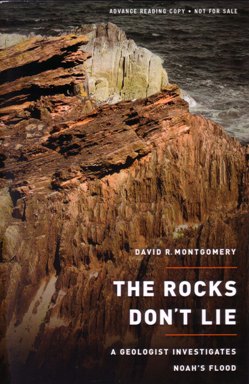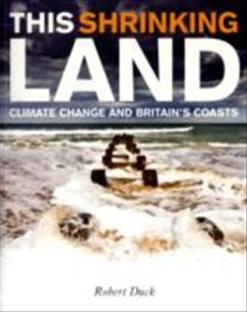 The rocks don't lie
The rocks don't lie
If the public opinion polls are correct around a third of people in Britain and nearly a half in the US consider it probable at least that the Earth was created in the last 10,000 years. Of these a considerable proportion would explain the rock record in terms of the year-long flood of Genesis. The uncomfortable truth is that a belief universally left for dead nearly two centuries ago is alive and well in the popular consciousness.
Although originally intended as a response to the ‘Flood Geology’ of Young Earth Creationism, Montgomery - a geomorphologist at the University of Washington - has written a very readable book that covers the complex interactions between geological science and the idea of a global flood over the centuries. Montgomery makes many good points. He demonstrates that the progress of science cannot be simply reduced to wise sceptical scientists triumphing over naive fools in dog collars. He points out that Christians have not always invoked either a literal seven-day creation or a year-long global flood. He tells us that, far from representing mainstream Christianity, Flood Geology is a barely 100 years old and arises from an unholy union of unorthodox theology and geological illiteracy. Throughout the text are scattered gentle but valid reminders that flood geology multiplies the inconceivable by the impossible.
Inevitably one wishes some things were done better. Montgomery tells us that a key failing of Wegener’s theory was the inability of the crust to sustain the required lateral forces, but neglects to tell us how this objection was answered (by the lithospheric plate). A more pressing problem in a polemic against fundamentalism is his handling of Bible interpretation, where he makes much of the possibility of multiple sources within Genesis. The attention of biblical scholars has shifted from debating how Genesis was formed to how the book in its final state is to be interpreted. He only very briefly alludes to those interpretations of Genesis 1 and 2 which suggest that it was never intended as Earth history anyway. Another regret is the slightly distanced treatment of Young Earth Creationists. They remain remote figures. Why they believe as they do is not fully explained.
This is a badly needed, engaging and even-handed book deserving the widest possible circulation. Order a copy for your local library.
THE ROCKS DON'T LIE; A GEOLOGIST INVESTIGATES NOAH'S FLOOD.
DAVID R MONTGOMERY. Published by: WW Norton and Company, 2012
ISBN 9780393082395. List price: £17.99
Reviewed by Chris Walley
 This Shrinking Land
This Shrinking Land
Hang on to your hats! Britain may not be such a safe place to live after all. This book starts at a cracking pace, describing a catalogue of major tsunamis and storm surge disasters, mythical submerged landmasses and lost villages - mixing facts, speculations and poems, and only pausing to take breath and ask the big question ‘why us?’.
Chapter two begins to provide an explanation through Holocene sea-level rise and global warming, before being diverted by the history of the curling Grand Match, the Tay Bridge disaster and the two-year exile of the boozy Lady Grange on Hesker in the Outer Hebrides. This, as you may have gathered, is no ordinary science textbook on coastal processes; it is a book with humour, anecdotes, strange facts and oddities jostling to be heard alongside the technical background.
The power of waves is introduced in Chapter three, not with Airy or Stokes wave theory, but with 2600 tonne blocks lost from harbour breakwaters, the 1849 breaching of Spurn (caused by excessive gravel extraction), the loss of Dunwich port and even Shakespeare’s Sonnet 64 (‘when I have seen the hungry ocean gain advantage on the kingdom of the shore’ – I was a Stratford boy and learnt this well!). The chapter ends with the seductive power of the sea, Agatha Christie and Jane Austin. Chapters follow in much the same vein, on coastal defences and the trouble that they can cause (‘defending the indefensible’), and the reasons why Scotland is different from England (clue: it’s something to do with the geology).
Chapter six focuses on the 21st Century conflicts and solutions, managed retreat, shoreline management plans and Donald Trump’s golf course. The final chapter poses the question ‘is my house with its sea view safe?’ and manages to convince me otherwise, even though I live 35 miles from the sea. At 185 pages, this is a pleasure to read, not too long-winded or bogged down by unwelcome technical detail.
The diversions into English literature, history and popular culture are a real joy and make the book stand out from the crowd. The layout and illustrations are adequate, some of the photographs look like they have been taken from old slides and the binding should be good enough to survive a good few reads. If you like your geology with a touch of human interest, then this book will appeal to you.
THIS SHRINKING LAND: CLIMATE CHANGE AND BRITAIN'S COASTS
ROBERT DUCK, Published by Dundee University Press, 2011. ISBN: 978 1 84586 118 6 hbk 208pp. List price: £20.00
Reviewed by Dr Mark Lee
 Military Uses of Hydrogeology
Military Uses of Hydrogeology
Napoleon famously said an “army marches on its stomach”, but when it comes to water there’s more to it than that - and the rest can be summed up simply as “mud!” This publication describes how the military needs hydrogeological expertise both to find water and predict ground conditions.
Twelve of this collection of 20 papers originated from a meeting at Burlington House (November 2009) held jointly between the History of Geology and Hydrogeological Groups, and the Institution of Royal Engineers. It starts with two papers covering pre 20th Century history, with Paul Younger’s amusing description of how a knowledge of local groundwater conditions was fundamental in two battles between the English and the Scots, and John Mather on how the eastern coastal defences were supplied with water during the 18th Century. Remaining papers cover warfare fromWW1 to Iraq and Afghanistan.
Papers are presented from both sides in both World Wars; the more recent German involvement in Somalia, Kosovo and Afghanistan; hydrogeological support to the US military 1917-2010; the US military’s investments in hydrogeology; and the tensions between Palatine and Israel over West Bank water resources. I was particularly pleased to see mention of the Wartime Pamphlets – a collection of well records put together in the 1940s - of great value to those of us who developed what is now the Environment Agency’s observation borehole network.
This is not the first Society publication on military geology with Geology and Warfare (Eds. Rose and Nathaniel, 2000) and a number of papers in both other Special Publications and QJEGH in recent years. A brief Internet search shows that the subject also attracts attention outside GSL meetings and publications at international symposia held over many years, and by other UK geological societies. This publication has added significantly to the growing literature on this subject and is recommended to those interested in the history of our science and its military applications.
Reviewed by: Rick Brassington
MILITARY USES OF HYDROGEOLOGY
TED ROSE & JOHN MATHER GSL Special Publication 362 ISBN: 978-1-86239-340-0 (hbk) Published: 29 March 2012. 376pp List price: £110.00
 Natural Hazards Atlas of Jamaica
Natural Hazards Atlas of Jamaica
This book has a large format and many excellent plates and useful maps and diagrams. It is well bound and suitable for anyone interested in Jamaica and the effects of its associated natural hazards. It is ideal for anyone with a general interest in this subject and students from GCSE to professional level. It is written in a jargon-free style and good value at £35.
Listing first the natural hazards typical of the area (floods (coastal and inland), landslides, earthquakes, hurricanes, tropical storms and tsunamis) it proceeds to explain them in detail. The authors show how secondary effects (e.g. liquefaction during earthquakes and floods during hurricanes) interact with the local physical environment as dictated by the geology (various types of limestone, ‘volcaniclastics’ and alluvial deposits) in the landscapes typically associated with these rocks (e.g. karst and alluvial plains).
The book contains many plates showing the local areas (especially the effects of the hazards on them), many large maps and informative diagrams detailing features such as hydrostratigraphy, rainfall, geology, landslide engineering effort and coastal flooding. Of particular interest are detailed maps of hurricane tracks, wind strengths and associated tables showing return periods.
The authors move on to consider Jamaica parish by parish, looking at the human geography, physical geography and hazard profiles of each. The book looks at coastal and inland flooding; both sudden and catastrophic (e.g. from storm surges and tsunamis) and gradual (from coastal erosion or sea level rise). It also lists the dates of the most significant hurricanes and earthquakes since the 19th Century.
The authors have supplied a useful glossary of terms used in the text and a list of references and some suggestions for further reading. This is essentially a general book for everyone rather than a detailed text book for the specialist. It is however very interesting for all and can be recommended most strongly.
NATURAL HAZARDS ATLAS OF JAMAICA
PARRIS LYEW-AYEE JR & RAFI AHMAD. Published by University of the West Indies Press, 2012 www.uwipress.com, www.monagis.com. Mona GeoInformatics Institute, University of the West Indies, Mona Hardback ISBN 978-976-640- 259-4 150pp List price £35.
Reviewed by Steve Rowlatt